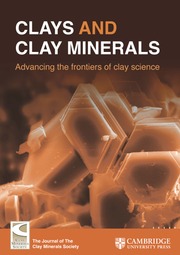Crossref Citations
This article has been cited by the following publications. This list is generated based on data provided by
Crossref.
Schwertmann, U.
Friedl, J.
Stanjek, H.
and
Schulze, D. G.
2000.
The effect of clay minerals on the formation of goethite and hematite from ferrihydrite after 16 years’ ageing at 25°C and pH 4 – 7.
Clay Minerals,
Vol. 35,
Issue. 4,
p.
613.
Ruan, H.D
Frost, R.L
and
Kloprogge, J.T
2001.
The behavior of hydroxyl units of synthetic goethite and its dehydroxylated product hematite.
Spectrochimica Acta Part A: Molecular and Biomolecular Spectroscopy,
Vol. 57,
Issue. 13,
p.
2575.
Ruan, H.D
Frost, R.L
Kloprogge, J.T
and
Duong, L
2002.
Infrared spectroscopy of goethite dehydroxylation. II. Effect of aluminium substitution on the behaviour of hydroxyl units.
Spectrochimica Acta Part A: Molecular and Biomolecular Spectroscopy,
Vol. 58,
Issue. 3,
p.
479.
Partiti, C. S. M.
Imbernon, R. A. L.
Franco, D. R.
Berquó, T. S.
and
Bevilacqua, J. E.
2002.
Hyperfine Interactions (C).
p.
453.
Gonzalez, Estela
Ballesteros, María C.
and
Rueda, Elsa H.
2002.
Reductive Dissolution Kinetics of Al-Substituted Goethites.
Clays and Clay Minerals,
Vol. 50,
Issue. 4,
p.
470.
Sambatti, J. A.
Costa, A. C. S.
Muniz, A. S.
Sengik, E.
Souza Junior, I. G.
and
Bigham, J. M.
2002.
Relações entre a substituição isomórfica de Fe por Al e as características químicas e mineralógicas de hematitas sintéticas.
Revista Brasileira de Ciência do Solo,
Vol. 26,
Issue. 1,
p.
117.
Sileo, E. E.
Solı´s, P. S.
and
Paiva-Santos, C. O.
2003.
Structural study of a series of synthetic goethites obtained in aqueous solutions containing cadmium(II) ions.
Powder Diffraction,
Vol. 18,
Issue. 1,
p.
50.
D'Amore, J. J.
Al‐Abed, S. R.
Scheckel, K. G.
and
Ryan, J. A.
2005.
Methods for Speciation of Metals in Soils.
Journal of Environmental Quality,
Vol. 34,
Issue. 5,
p.
1707.
Stumpf, Silvia
Stumpf, Thorsten
Dardenne, Kathy
Hennig, Christoph
Foerstendorf, Harald
Klenze, Reinhardt
and
Fanghänel, Thomas
2006.
Sorption of Am(III) onto 6-Line-Ferrihydrite and Its Alteration Products: Investigations by EXAFS.
Environmental Science & Technology,
Vol. 40,
Issue. 11,
p.
3522.
Murray, G. Christopher
and
Hesterberg, Dean
2006.
Iron and Phosphate Dissolution during Abiotic Reduction of Ferrihydrite‐Boehmite Mixtures.
Soil Science Society of America Journal,
Vol. 70,
Issue. 4,
p.
1318.
Pedersen, Hanne D.
Postma, Dieke
and
Jakobsen, Rasmus
2006.
Release of arsenic associated with the reduction and transformation of iron oxides.
Geochimica et Cosmochimica Acta,
Vol. 70,
Issue. 16,
p.
4116.
Dideriksen, K.
Christiansen, B.C.
Baker, J.A.
Frandsen, C.
Balic-Zunic, T.
Tullborg, E.
Mørup, S.
and
Stipp, S.L.S.
2007.
Fe-oxide fracture fillings as a palæo-redox indicator: Structure, crystal form and Fe isotope composition.
Chemical Geology,
Vol. 244,
Issue. 1-2,
p.
330.
Bhuiyan, Tarequl Islam
Nakanishi, Makoto
Kusano, Yoshihiro
Fujii, Tatsuo
Takada, Jun
and
Ikeda, Yasunori
2007.
Synthesis, Structures and Properties of the Cerium Doped Hematite Co-existing with CeO2.
Journal of the Japan Society of Powder and Powder Metallurgy,
Vol. 54,
Issue. 2,
p.
112.
Ruby, Christian
Abdelmoula, Mustapha
Aissa, Rabha
Medjahdi, Ghouti
Brunelli, Michela
and
François, Michel
2008.
Aluminium substitution in iron(II–III)-layered double hydroxides: Formation and cationic order.
Journal of Solid State Chemistry,
Vol. 181,
Issue. 9,
p.
2285.
Feng, Weimin
and
Yapp, Crayton J.
2008.
Experimental tests of the effects of Al substitution on the goethite–water D/H fractionation factor.
Geochimica et Cosmochimica Acta,
Vol. 72,
Issue. 5,
p.
1295.
Batista, Marcelo A.
da Costa, Antonio C. S.
Bigham, Jerry M.
de Santana, Henrique
Zaia, Dimas A. M.
and
de Souza junior, Ivan G.
2010.
Mineralogical, Chemical, and Physical Characterization of Synthetic Al-Substituted Maghemites (γ−Fe2−xAlxO3).
Clays and Clay Minerals,
Vol. 58,
Issue. 4,
p.
451.
Krehula, Stjepko
and
Musić, Svetozar
2010.
Growth of uniform lath-like α-(Fe,Al)OOH and disc-like α-(Fe,Al)2O3 nanoparticles in a highly alkaline medium.
Materials Chemistry and Physics,
Vol. 123,
Issue. 1,
p.
67.
Hansel, C.M.
Learman, D.R.
Lentini, C.J.
and
Ekstrom, E.B.
2011.
Effect of adsorbed and substituted Al on Fe(II)-induced mineralization pathways of ferrihydrite.
Geochimica et Cosmochimica Acta,
Vol. 75,
Issue. 16,
p.
4653.
Twidwell, L. G.
and
McCloskey, J. W.
2011.
Removing arsenic from aqueous solution and long-term product storage.
JOM,
Vol. 63,
Issue. 8,
p.
94.
Masue-Slowey, Yoko
Loeppert, Richard H.
and
Fendorf, Scott
2011.
Alteration of ferrihydrite reductive dissolution and transformation by adsorbed As and structural Al: Implications for As retention.
Geochimica et Cosmochimica Acta,
Vol. 75,
Issue. 3,
p.
870.

